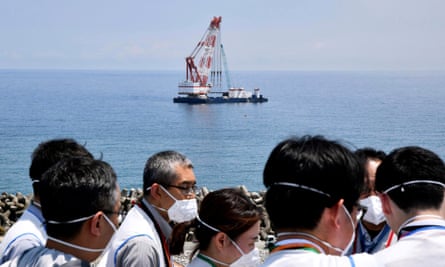Every day fisher Charlie Maleb takes his string lines and his nets out from Wala Island, Vanuatu, into the Pacific Ocean.
The 54-year-old drops his net around 5am and waits an hour before pulling it out, hoping to catch sardines, poulet and mangrove fish. Later in the day Maleb drops a line attached to a traditional fishing rod, fashioned out of a long tree branch.
“Once a fish gets the bait, the stick falls down and I have to hurry up to pull in the catch,” says Maleb.
Fishing is part of life for many people on Wala Island, much of the catch is for them to eat, while a small amount is sold for money to pay for goods and medicine.
“We use the catch for our daily source of protein, we make sure we have enough first before we sell,” says Maleb.
Maleb is one of 2.3 million people who live in the Pacific Islands and rely on the ocean for food and income, many of whom hold concerns over Japan’s plans to release more than 1m metric tonnes of treated radioactive wastewater into the sea.
The water was mostly used to cool reactors after the Fukushima Daiichi nuclear plant was hit by an earthquake and tsunami in 2011 that led to meltdowns in three of its reactors, in the world’s worst nuclear accident since Chornobyl 25 years earlier. The water is being stored in about 1,000 tanks which will soon reach full capacity.
Japan has said the water is safe and on Tuesday the head of the UN nuclear agency will visit the country to deliver its final report on the discharge plan. No date has been set for the release but it is expected in the coming months.
The water will be treated to remove most radioactive materials but will still contain tritium, a naturally occurring radioactive form of hydrogen that is technically difficult to separate from water.
Japan says the water will be diluted to levels safer than international standards and will be released gradually into the ocean over decades, making it harmless to people and marine life.
Some scientists have said that the long-term effects are unknown and the release should be delayed. Others say it’s safe though there is still a need for transparency, and independent experts must be allowed to sample, monitor and look at the data.
Many in the Pacific aren’t fully informed about Japan’s plans. Despite their distance from Japan, fishers like Maleb say they are concerned about the impacts of the discharge.
“I have no idea what Japan is preparing to do, we have been depending on seafood for almost my entire life, we live to feed on fish every day and it’s our source of income for us,” says Maleb.
Harry Farhall spearfishes in the coral reefs off Papua New Guinea’s New Ireland province, which he says are a “breeding ground for tuna and a migratory path for whales migrating up north and down south.” He says everyone in the area relies on the ocean and is worried about the water release.
“We can’t risk the marine environment and the people who depend on it. We are not prepared to deal with the effects of the nuclear waste,” he says.
‘Much at risk’
The Pacific Islands Forum (PIF), the peak intergovernmental organisation representing the region, has been consulting with Japan over the release for the past two years and in January said it had “grave concerns” over the plans. Last month the PIF issued a statement drawing attention to international laws against dumping nuclear waste in the Pacific Ocean.
“Our people do not have anything to gain from Japan’s plan but have much at risk for generations to come,” said PIF secretary general Henry Puna.
“It is clear in my mind that more work and dialogue is needed to ensure that we all come to a common understanding on this issue,” Puna said in the statement.
Puna said the path forward should involve “comprehensive international consultation particularly with affected states”.
Last month Papua New Guinea’s prime minister, James Marape, backtracked on comments in support of the water release, reportedly telling parliament “Nuclear is not allowed in our waters.”
Others have shown more support. In June Palau president Surangel Whipps Jr said he was not opposed to the plan to discharge the water after a visit to the Fukushima plant. “We’ve made a decision that what they’re doing is right and we should support them,” he said in an interview with Reuters.

Japan has sought the support of the International Atomic Energy Agency (IAEA) to ensure global standards are met. The IAEA, the UN’s nuclear watchdog, conducted missions to Japan in 2022.
Authorities in Japan have begun final inspections on the system to be used to discharge the water after plant operator Tepco last week installed the final piece of equipment needed for the release.
Maleb wants his government to do more to inform him about the plan and the possible risks.
“I don’t have any information and would like to know more,” Maleb says. “If Japan pushes through, I don’t know but I think it will affect us.
“The generations to come will also depend on our beautiful reefs and natural and original sea species to feed on.”

